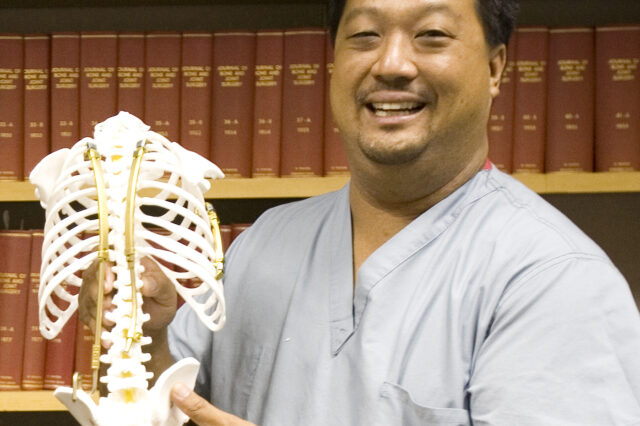Boy undergoes rare surgery to correct life-threatening disease

Raymund Woo, M.D., associate professor of orthopaedic surgery and chief of pediatric orthopaedics at UF’s College of Medicine (Photo by Sarah Kiewel/University of Florida)
A 4-year-old Ocala boy born with a severe form of scoliosis became one of the first children in the Southeast to receive a titanium rib device that will allow his rib cage to expand as he grows, said University of Florida surgeons, who performed the two-and-a-half-hour operation today at Shands at UF medical center.
The device spreads vertically to expand his chest cavity, creating more room for his organs while correcting his scoliosis, a curvature of the spine. Unlike adolescents who develop scoliosis, children born with the disease usually have ribs that have fused, preventing their chest cavities from growing even as the organs inside them continue to enlarge, said UF pediatric orthopaedic surgeon Raymund Woo, M.D., who led the procedure. Woo is an associate professor of orthopaedic surgery and chief of pediatric orthopaedics at UF's College of Medicine.
Prior to the development of the titanium rib, a thin bar that can be manually adjusted so the rib cage can expand over time, many children with severe congenital scoliosis died as their bodies outgrew their fused ribs, Woo said. Fusing rods into the spine, the standard surgery to treat the disease in teens and adults, is not considered an option for small children: Although it would straighten their spines, it would not solve the problem of multiple fused ribs, Woo said.
"They don't have enough room in their rib cages for their organs to grow," he said. "(Without that) these kids are doomed to die. This is really a major step forward in the treatment of this disease."
Only about 1,000 children in the United States have this severe form of congenital scoliosis with fused ribs, Woo said. The main problem these children face is that their fused ribs constrict lung development, said George H. Thompson, a professor of orthopaedics and director of pediatric orthopaedics at Case Western Reserve University. This makes the titanium rib's ability to expand the chest cavity particularly important, he said.
"The lung really gets most of its development in the first eight years of life," said Thompson, also president of the Scoliosis Research Society.
Veptr 1:This illustration shows what vertical expanding prosthetic titanium ribs look like after they have been placed on a child's rib cage. (Photo by Synthes)
Shamar Honor, who has been Woo's patient since he was about 6 months old, received two of the titanium ribs. Woo had to separate some of the fused ribs so they could be attached to his rib cage. The only parts of the vertical ribs that actually touch the boy's bones are the points where they are attached, Woo said.
Shamar was listed in good condition after the surgery, Woo said. Woo will not know how well the device works until Shamar's scoliosis worsens or improves, he said.
The titanium ribs have additional length inside of them, which will allow Woo to expand them by making small incisions over the spots where the device is attached to Shamar's rib. He will have to come back every six months to have them adjusted.
"I thought it was good news," said Robbietta Honor, Shamar's mother, recalling the day when Woo told her about the surgery. "I can notice it more as he gets older, one side is growing and the other side isn't. He's lopsided."
Because the surgery is so unusual, Woo and UF pediatric surgeon David Kays, M.D., both received special training to learn how to perform it. Kays assisted in the surgery and Vincent Deeney, M.D., an orthopaedic surgeon from the University of Pittsburgh who has performed the surgery before, was in the room to offer guidance. Another team was also in place to monitor Shamar's spinal cord, Woo said.
The U.S. Food and Drug Administration approved the device, produced by the Paoli, Pa., company Synthes, for humanitarian use in 2004. According to the FDA, the humanitarian use exemption was put in place to encourage companies to develop devices and treatments for conditions that affect fewer than 4,000 people. Fewer cases can dissuade some companies from sinking research dollars into a device because fewer patients sometimes equate to less profit, Woo said.
Aside from correcting scoliosis and allowing the rib cage to expand, the device will also allow Shamar to maintain flexibility, something that older scoliosis patients typically sacrifice when rods are fused into their spines.
"This allows you to have the best of both worlds," Woo said.